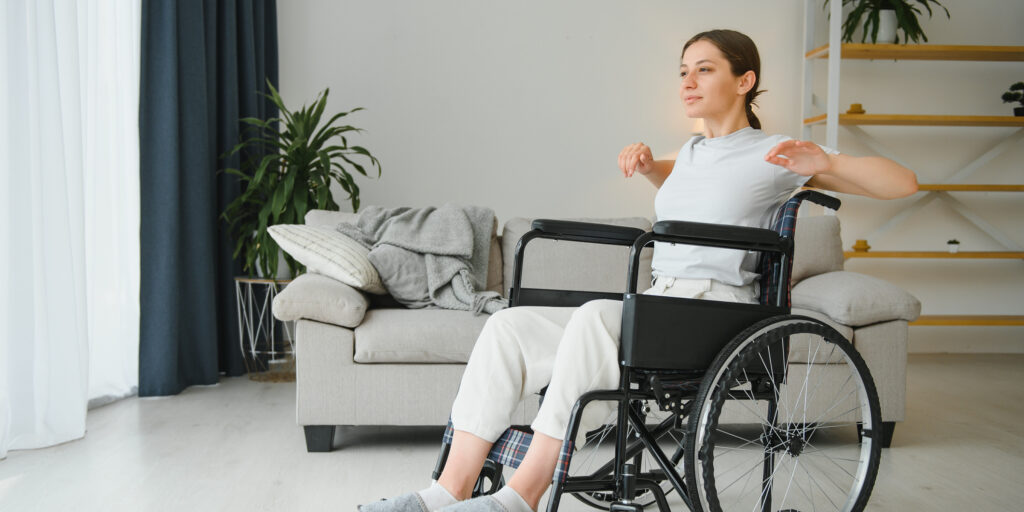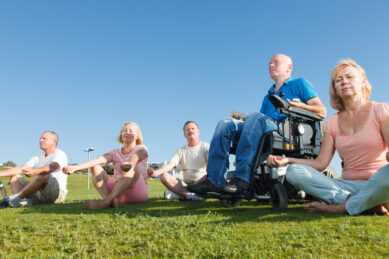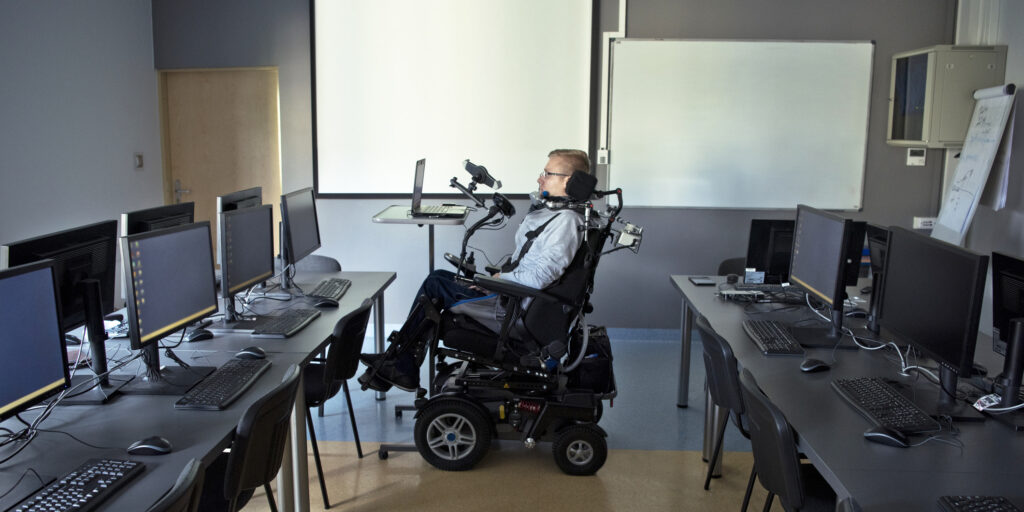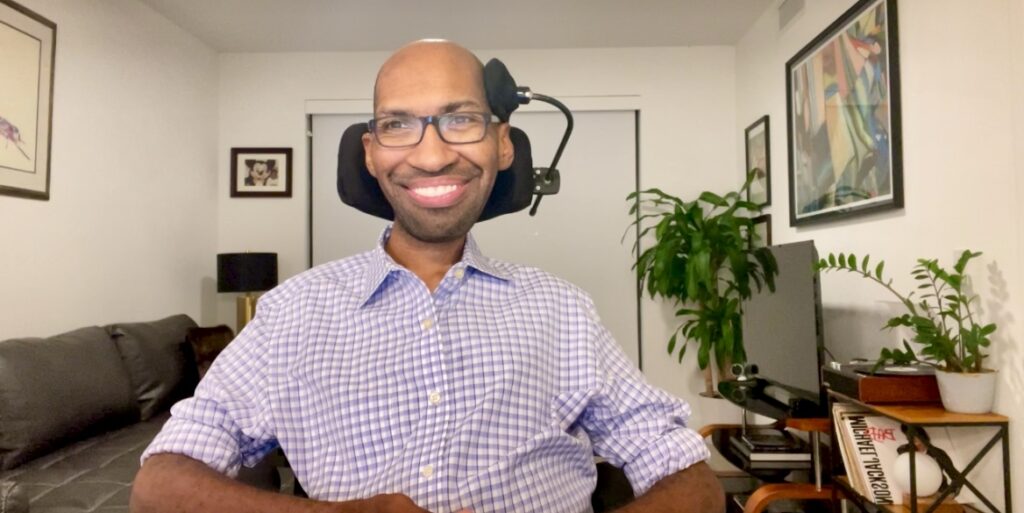
Pro Tips to Add More Movement to Your Day
By Rebecca Hume | Friday, March 28, 2025
Adding more movement or physical activity to each day is a common goal among people living with neuromuscular disease. However, muscle fatigue, weakness, and limited strength or range of motion can make increasing physical activity a challenge. The age-old conundrum of “if you don’t use it, you lose it” conflicts with the need for rest and the dangers of overexertion, but ultimately – more movement is a crucial component to increased muscle wellness.
Finding a balance

Occupational Therapist Kristin Myers
“Our bodies, brains, and integrated systems are designed to move and interact. The components of our bodies and systems that we do lose if we don’t use are our strength, endurance, and flexibility,” says Kristin Myers, an Occupational Therapist and Founder of Myers Therapy Team and The Hope and Recovery Foundation.
Kristin has worked with individuals living with neuromuscular disease for over 30 years and is a strong believer that the more muscle function and movement that can be sustained through small exercises, the slower mobility will decline. By increasing daily movement, individuals have a better chance of preventing contractures, maintaining independence, and maintaining (and optimizing) muscle function.
“The more immobility or lack of flexibility our body has, the more strength or power it takes to move through that tightness actively. The less power or strength that we have, the less movement range we can go through, and therefore, the less flexibility we can reinforce,” she says. “The fewer times we move through available ranges, the less endurance we build or sustain, and the less endurance we build or sustain results in an eventual reduction of power or strength and ability.”
It is important to balance an increase in activity with rest, and to listen to your body to avoid fatigue or muscle damage. Everybody – and every body – is different. There is no one-size-fits-all for how much movement your body needs to maintain strength and flexibility without increasing fatigue or negatively impacting muscle health. It is important to talk to your doctors or therapists before adding exercises to your daily routine to ensure that exercises and activities are safe and appropriate for your condition.
“The neuromuscular disease umbrella covers a wide variety of diagnoses with varying levels of ambulation, muscle use, and dexterity,” Kristin says. She advises others to listen to their body’s signals and stresses the importance of identifying healthy limits and adding rest breaks. One tip she shares for measuring fatigue is to pay attention to energy recovery after movement. With intentional rest breaks between activities or exercise, she says that one should feel a recovery of energy within two minutes. If it takes longer, lessen the amount of activity and increase rest breaks to manage fatigue by not allowing the energy tank to get empty.
Increasing activity at home
There are multiple ways to intentionally integrate more movement at home, whether through increasing participation in tasks related to areas of daily living, creating and implementing exercise or range of motion (ROM) regiments, or adding muscle movements to leisure activities. Focus on small, manageable activities throughout the day.
Turn daily tasks into mini workouts by increasing your involvement, reaching, and effort. This can be especially beneficial if you typically have hands-on assistance with areas of daily living. Identify areas where you can increase your movement (without draining your energy bank or risking injury) by manually assisting with portions of a task. Whether that is trying to hold your arms in the air after an attendant raises them to change your clothes or assisting with aspects of meal prep that are within your abilities.
“Do the things you can do efficiently without assistance. Try not to ask for assistance for things you can do yourself and when assistance is needed, ask for assistance for the portion of the task you need help with, then take it from there,” Kristin says. “Consider fatigue and think ahead for the next few hours to plan when your activity will be and when your next rest break is.”

Adapted yoga provides low impact exercises and stretches.
Adding intentional exercise or range of motion exercise to each day also makes it easier to schedule both physical activity and the necessary rest after. Plan exercise for a part of the day when you have high energy and the ability to rest and refuel afterwards. Seek adapted exercises that are beneficial for people living with neuromuscular disease.
Muscle strengthening exercises that work smaller muscles through a pushing or pulling motion (with or without resistance) can easily be done at home from a seated position. And there are a wide variety of exercises and stretches specifically designed to be executed while sitting or positioned in a wheelchair. Calf raises, straightening and bending knees, reaching in various directions with arms, and side twists are simple exercises (if your body allows). If your diagnosis makes it difficult to navigate exercises independently, you can reap the same benefits through assisted range of motion exercises (where a caregiver helps move your body to gently stretch and warm muscles). Plan a discussion with your medical professionals to determine the best exercises and frequency for you.
One handy hack to add more movement to your day without drastically changing your day-to-day routine is to plan your exercises to coincide with a specific activity. If you are going to watch a movie in the evening add exercise or range of motion to that window of time and increase your movement while you watch. Incorporate flexibility exercises or stretching into daily activities. If you require hands-on-assistance to change clothes, use that time to integrate range of motion exercises to the movement that they are already assisting. Use meal prep and clean up time to implement pushing and pulling exercises as you reach for different items. Add a few repetitious movements to hygiene routine in order to increase muscle use. Find areas that work for you to add movement to your daily routine.
Adopting and adapting an active lifestyle
Another way to add more movement to your life is to increase physical activity by participating in adaptive sports, whether that is by joining a team, taking a class, or participating independently. Its easier than ever to get involved with adaptive sports with many areas offering adaptive basketball, baseball, tennis, soccer, and more. There are also a wide variety of low-impact sports that you can do on your own schedule. Low-impact sports help with joint mobility, muscle strength, and flexibility while also offering cardio benefits. Check with local YMWCA’s and local studios to find adapted yoga, tai chi, or water aerobics classes.
If organized sports are not the thing for you, consider joining a local pool and having your caregiver assist with swimming, stretching, and aerobic activity in the water. Contact local gyms to determine if they have adaptive equipment and accessible work out space. Plan seated strolls with friends or family. Making movement fun by choosing activities that you enjoy will help you to stay motivated – and moving!
Next Steps and Useful Resources
- Check out Quest’s Guide to Getting Involved in Adaptive Sports.
- Read more about Adaptive Exercises for People with Neuromuscular Diseases.
- Stay up-to-date on Quest content! Subscribe to Quest Magazine and Newsletter.
Disclaimer: No content on this site should ever be used as a substitute for direct medical advice from your doctor or other qualified clinician.




